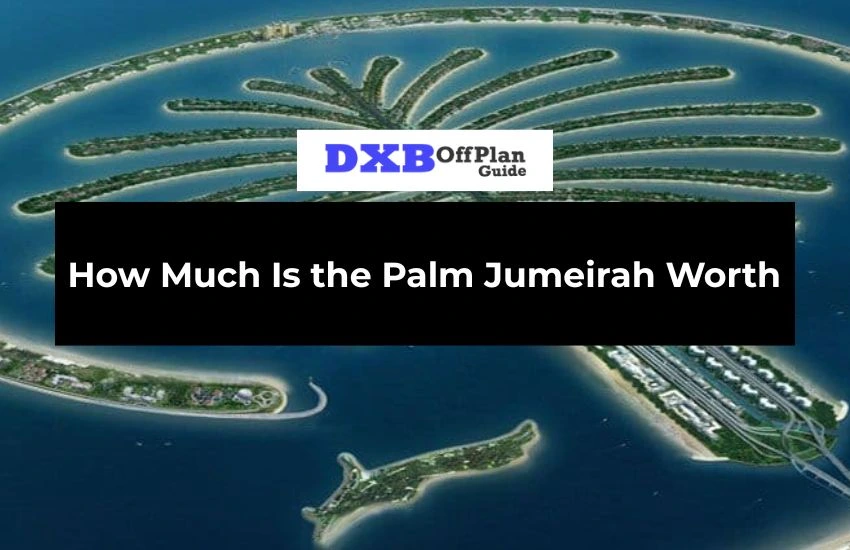The Palm Jumeirah represents one of the most ambitious real estate developments in modern history—an artificial archipelago that cost $12 billion to construct but has generated substantially more in property sales, tourism revenue, and economic impact. While the initial construction figure provides a baseline, the palm-shaped island’s true worth encompasses real estate values, hospitality revenue, infrastructure investment, and its role as a global luxury destination. This definitive analysis breaks down Palm Jumeirah’s complete valuation across construction costs, current property values, and economic impact, providing a realistic assessment of what this engineering marvel contributes to Dubai’s economy and global standing.

Construction Cost vs Current Real Estate Value
The island’s $12 billion construction cost represents only the foundation for understanding its current market valuation and asset appreciation.
-
Original Development Budget: $12 billion (2001-2011 construction)
-
Land Reclamation: 110 million cubic meters of sand and 7 million tons of rock
-
2025 Replacement Cost: Estimated $25-30 billion, accounting for modern construction costs
-
Infrastructure Premium: Advanced water, electricity, and transportation systems
The replacement cost alone positions Palm Jumeirah’s property valuation significantly higher than initial figures. Construction inflation and enhanced engineering standards mean recreating the island today would require more than double the original budget.
Real Estate Portfolio Value The Core Asset
Palm Jumeirah’s residential and commercial properties represent the cornerstone of its comprehensive valuation.
Residential Property Values
The island’s luxury villas and apartments command premium prices in Dubai’s real estate market.
-
Villa Prices: $5-25 million for beachfront properties
-
Apartment Values: $1-8 million for premium units with sea views
-
Annual Appreciation: 7-12% based on the latest market data
-
Rental Yields: 4-6% for luxury residential properties
Commercial and Hospitality Assets
The island’s hotel and commercial properties generate substantial revenue streams.
-
Hotel Inventory: 28 luxury hotels, including Atlantis The Palm and Waldorf Astoria
-
Retail Space: 150,000+ square meters of premium retail areas
-
Restaurant Portfolio: 200+ dining establishments across the crescent
-
Entertainment Venues: Beach clubs, marinas, and leisure facilities
Annual Economic Performance The Revenue Engine
Palm Jumeirah generates substantial annual revenue through multiple channels that contribute to its overall worth.
-
Tourism Revenue: $1.2-1.5 billion from hotel stays and visitor spending
-
Property Sales: $800 million in annual real estate transactions
-
Retail Performance: $400-500 million from shopping and dining
-
Service Charges: $150-200 million from residential and commercial properties
-
Marina Operations: $50-75 million from berthing and yacht services
Infrastructure and Development Costs The Hidden Value
The island’s extensive infrastructure represents significant value beyond surface-level property valuations.
-
Transportation Network: 11.8 kilometers of monorail and road systems
-
Utility Infrastructure: Advanced water, electricity, and telecommunications
-
Marine Protection: Breakwaters and coastal defense systems
-
Green Spaces: Parks, gardens, and landscaped areas
-
Public Facilities: Schools, medical centers, and community services
Brand Value and Global Recognition
Palm Jumeirah’s status as an iconic global destination creates substantial intangible value.
-
Brand Equity: Estimated $8-10 billion in global recognition value
-
Tourism Draw: Primary attraction for 20% of Dubai’s luxury visitors
-
Media Coverage: $2-3 billion in equivalent advertising value
-
Architectural Status: Recognized as one of the modern engineering wonders
Comparative Global Development Valuation
Placing Palm Jumeirah’s worth alongside other global mega-developments reveals its unique value proposition.
-
The World Islands Dubai: Different scale and development timeline
-
Sentosa Cove Singapore: Similar luxury positioning but smaller scale
-
Pearl Qatar: Comparable artificial island development
-
Palm Jebel Ali: Larger but currently paused development
Property Market Performance Analysis
The island’s real estate market demonstrates consistent strength and premium positioning.
-
Price Premium: 50-80% higher than mainland comparable properties
-
Demand Consistency: Maintains strong buyer interest across market cycles
-
Rental Performance: 85-90% occupancy rates for luxury properties
-
Investment Appeal: Top choice for high-net-worth individuals
Frequently Asked Questions
Q1: What was the construction cost of Palm Jumeirah?
Palm Jumeirah’s construction cost was approximately $12 billion between 2001 and 2011. This figure included land reclamation, infrastructure development, and initial property construction across the trunk, fronds, and crescent areas.
Q2: How many properties are on Palm Jumeirah?
The island contains approximately 4,500 residential villas and 30,000 apartments across its various sections, along with 28 luxury hotels and numerous commercial establishments, creating a comprehensive mixed-use community.
Q3: What is the current property value on Palm Jumeirah?
Current property values range from $1 million for apartments to over $25 million for premium beachfront villas. The island maintains a significant price premium compared to mainland Dubai properties due to its unique location and amenities.
Q4: How does Palm Jumeirah compare to other Dubai developments?
As Dubai’s first and most established artificial island, Palm Jumeirah commands higher property values and greater global recognition than newer developments, though projects like Dubai Marina and Downtown Dubai serve different market segments.
Q5: What is the annual economic impact of Palm Jumeirah?
The island generates an estimated $2-2.5 billion in annual economic impact through tourism, real estate transactions, retail spending, and service industries, representing a significant contribution to Dubai’s overall economy.
Q6: How has Palm Jumeirah affected Dubai’s global image?
The development established Dubai as a leader in ambitious engineering projects and luxury tourism, significantly enhancing the city’s global profile and attracting international attention to its innovation capabilities.





Leave a Reply